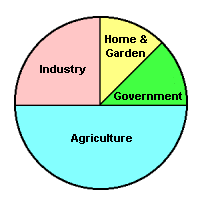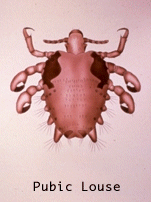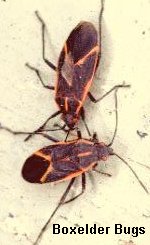Insects as Pests
Most children are fascinated by the living organisms that share their environment; they love to watch an ant groom itself, a bee gather nectar, or a spider build its web. But this interest is seldom encouraged in our busy society. Adult attitudes toward insects (and related arthropods) are generally negative — the ant is a nuisance, the bee might sting, and the spider… well just look at what happened to little Miss Muffett! Through these attitudes we send our children a clear, subconscious message that insects (and most other parts of the natural environment) are unsafe, unclean, and unappealing. Most children adopt this viewpoint before they leave elementary school; they grow up, like their parents, convinced that the “only good bug is a dead bug”.
 The mass media continually reinforces this belief with reports about killer bees, giant grasshoppers, poisonous spiders, and crops destroyed by marauding bands of insects. This cultural indoctrination has produced a society that seems to be increasingly consumed by efforts to eliminate insects from all facets of daily life. Pest control has become big business. Nearly 75 million pounds of broad-spectrum insecticides are manufactured and sold each year for use in American homes and gardens. Annual revenues from insecticide sales to homeowners exceed 450 million dollars.
The mass media continually reinforces this belief with reports about killer bees, giant grasshoppers, poisonous spiders, and crops destroyed by marauding bands of insects. This cultural indoctrination has produced a society that seems to be increasingly consumed by efforts to eliminate insects from all facets of daily life. Pest control has become big business. Nearly 75 million pounds of broad-spectrum insecticides are manufactured and sold each year for use in American homes and gardens. Annual revenues from insecticide sales to homeowners exceed 450 million dollars.
Aside from ladybugs (which are considered “cute”) and butterflies (they’re “pretty”), most insects are regarded with a certain degree of fear or revulsion. A few, like honey bees and praying mantids, may be recognized as “useful”, but all others are just “pests”.
This notion of “pest” is unique to humans and completely anthropocentric. We define pests in terms of our own standards of good and bad — standards that are often based largely on aesthetics, economics, and personal welfare, and shaped by cultural bias and personal experiences. A “pest” is defined as any organism that causes annoyance or injury to human beings, human possessions, or human interests. The injury may be physical (bites and stings), medical (causing illness or disease), or economic (monetary loss to goods or property). Injury may arise directly from the pest itself, or may develop indirectly as a result of the actions or behavior of the pest.
 Despite public perceptions, there are relatively few insects that really fit the above definition of a pest. Admittedly, a few species (very few) appear to have “no redeeming social value” (pubic lice and bed bugs spring quickly to mind). But most insects we encounter in our daily lives are either benign or beneficial. Out of the 800,000 – 1,000,000 species of insects that have been described so far, not more than 1,000 (about 1/10 of 1%) can be regarded as serious pests, and less than 10,000 (about 1%) are even occasional or sporadic pests.
Despite public perceptions, there are relatively few insects that really fit the above definition of a pest. Admittedly, a few species (very few) appear to have “no redeeming social value” (pubic lice and bed bugs spring quickly to mind). But most insects we encounter in our daily lives are either benign or beneficial. Out of the 800,000 – 1,000,000 species of insects that have been described so far, not more than 1,000 (about 1/10 of 1%) can be regarded as serious pests, and less than 10,000 (about 1%) are even occasional or sporadic pests.
In reality, many of the insects we label as pests are essential components of our natural ecosystem — we can’t seem to live with them, but neither could we live without them! Termites, for example, are serious pests when they move into the floor joists of a home. An infestation may cost hundreds of dollars to eradicate, and if ignored, could eventually destroy the house. But in a forest ecosystem, these termites are beneficial. They are a vital component of the biogeochemical cycle that releases nutrients from dead plant material. Without termites and other decomposers living on the forest floor, organic molecules would be locked away in piles of dead wood, unavailable to living organisms until released by fire or erosion.
In general, the species we regard as pests usually affect us in one or more of the following ways:
- They are an annoyance or nuisance
- They endanger human health or safety
- They threaten the welfare of useful plants or domestic animals
- They damage stored products or structural materials
These categories are not mutually exclusive. Many of our most serious pests (cockroaches, for example) could be listed in several of these categories.
Nuisance and Aesthetic Pests
 Aesthetic pests cause no damage and inflict no injury. They may be annoying, unsightly, or disruptive (like chirping crickets that keep you awake at night, or dance flies that swarm around your head in the spring), but their presence will cause no injury or financial liability. An insect is most likely to be regarded as an aesthetic pest when it inadvertently invades a home or business establishment. The human occupants of these environments are seldom tolerant of other species — even the most benign visitors are promptly executed (or forcibly evicted). Boxelder bugs (Boisea trivittata) are typical victims of such intolerance. In autumn, homeowners may become upset when they discover aggregations of these red and black insects on brick walls, foundations, or concrete steps near a residence. The bugs may be numerous and occasionally annoying, but they do not bite or sting, they pose no threat to the house or its contents, and they will eventually move elsewhere to find overwintering quarters. Still, a large can of insecticide is the homeowner’s typical response.
Aesthetic pests cause no damage and inflict no injury. They may be annoying, unsightly, or disruptive (like chirping crickets that keep you awake at night, or dance flies that swarm around your head in the spring), but their presence will cause no injury or financial liability. An insect is most likely to be regarded as an aesthetic pest when it inadvertently invades a home or business establishment. The human occupants of these environments are seldom tolerant of other species — even the most benign visitors are promptly executed (or forcibly evicted). Boxelder bugs (Boisea trivittata) are typical victims of such intolerance. In autumn, homeowners may become upset when they discover aggregations of these red and black insects on brick walls, foundations, or concrete steps near a residence. The bugs may be numerous and occasionally annoying, but they do not bite or sting, they pose no threat to the house or its contents, and they will eventually move elsewhere to find overwintering quarters. Still, a large can of insecticide is the homeowner’s typical response.
Buzzing or swarming insects are often more than just nuisance pests. “Fly worry” is recognized by poultry and livestock producers as a serious threat to their livelihood. Large fly populations (even non-biting flies) can decrease milk production in a herd of dairy cattle, depress egg laying in a poultry house, or reduce daily weight gain of feeder pigs. Economic losses associated with nuisance pests can range from negligible to severe. At least a dozen species of bird lice (Mallophaga) are considered economic pests by poultry producers. Although these lice feed only on feathers and dry skin, they cause enough irritation to induce sleeplessness, loss of appetite, and poor health. Lice populations in excess of 35,000 individuals have been collected from the body of a single chicken.
To some extent, a fear of insects is quite normal. You may react instinctively to brush away an annoying fly or jump back at the sudden appearance of a spider. But some people are so afraid of insects that it can affect their ability to function normally in society. These people suffer from entomophobia, an irrational and often debilitating fear of insects. People with severe entomophobia are frequently confined to their homes; they are unable to enjoy gardening, walking in the woods, or visiting the beach because they dread an encounter with an insect. Psychiatrists estimate that 1-2% of the adult U.S. population is affected by some degree of entomophobia that limits their activity or interferes with their quality of life.
Occasionally, a fear or loathing of insects is compounded by the victim’s own imagination. Some people convince themselves that their body has become “infested with parasites” and go to great lengths to rid themselves of the imaginary vermin. This type of paranoia, known medically as delusionary parasitosis, is generally regarded as a form of obsessive/compulsive behavior. It is common enough to be recognized as a psychological disorder by the American Medical Association. One case study, reported in 1957, documents a woman who believed she was infested with “termites” that would periodically emerge from the joints of her arms and legs. Her physician sent her home to “collect some specimens” and a week later she returned with a plastic bag full of “termites” which, upon microscopic examination, proved to be scabs and skin fragments she had picked or scratched from her body. More about entomophobia
and delusionary parasitosis Treatment of entomophobia and delusionary parasitosis is difficult because the fear is irrational. Some success has been achieved with behavioral therapies that involve systematic desensitization, starting first with imagery (pictures) and gradually working up to more direct types of exposure.

